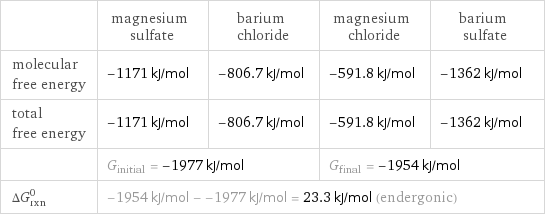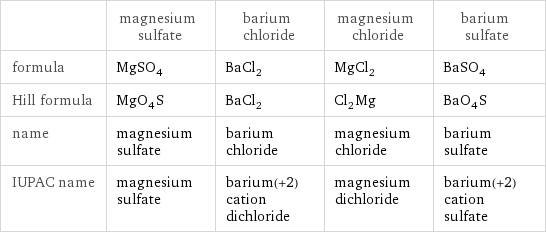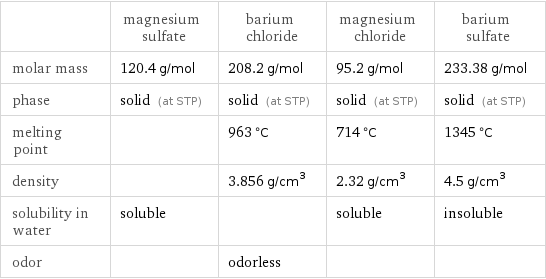Input interpretation

MgSO_4 magnesium sulfate + BaCl_2 barium chloride ⟶ MgCl_2 magnesium chloride + BaSO_4 barium sulfate
Balanced equation

Balance the chemical equation algebraically: MgSO_4 + BaCl_2 ⟶ MgCl_2 + BaSO_4 Add stoichiometric coefficients, c_i, to the reactants and products: c_1 MgSO_4 + c_2 BaCl_2 ⟶ c_3 MgCl_2 + c_4 BaSO_4 Set the number of atoms in the reactants equal to the number of atoms in the products for Mg, O, S, Ba and Cl: Mg: | c_1 = c_3 O: | 4 c_1 = 4 c_4 S: | c_1 = c_4 Ba: | c_2 = c_4 Cl: | 2 c_2 = 2 c_3 Since the coefficients are relative quantities and underdetermined, choose a coefficient to set arbitrarily. To keep the coefficients small, the arbitrary value is ordinarily one. For instance, set c_1 = 1 and solve the system of equations for the remaining coefficients: c_1 = 1 c_2 = 1 c_3 = 1 c_4 = 1 Substitute the coefficients into the chemical reaction to obtain the balanced equation: Answer: | | MgSO_4 + BaCl_2 ⟶ MgCl_2 + BaSO_4
Structures

+ ⟶ +
Names

magnesium sulfate + barium chloride ⟶ magnesium chloride + barium sulfate
Reaction thermodynamics
Enthalpy

| magnesium sulfate | barium chloride | magnesium chloride | barium sulfate molecular enthalpy | -1285 kJ/mol | -855 kJ/mol | -641.3 kJ/mol | -1473 kJ/mol total enthalpy | -1285 kJ/mol | -855 kJ/mol | -641.3 kJ/mol | -1473 kJ/mol | H_initial = -2140 kJ/mol | | H_final = -2115 kJ/mol | ΔH_rxn^0 | -2115 kJ/mol - -2140 kJ/mol = 25.4 kJ/mol (endothermic) | | |
Gibbs free energy

| magnesium sulfate | barium chloride | magnesium chloride | barium sulfate molecular free energy | -1171 kJ/mol | -806.7 kJ/mol | -591.8 kJ/mol | -1362 kJ/mol total free energy | -1171 kJ/mol | -806.7 kJ/mol | -591.8 kJ/mol | -1362 kJ/mol | G_initial = -1977 kJ/mol | | G_final = -1954 kJ/mol | ΔG_rxn^0 | -1954 kJ/mol - -1977 kJ/mol = 23.3 kJ/mol (endergonic) | | |
Equilibrium constant
![Construct the equilibrium constant, K, expression for: MgSO_4 + BaCl_2 ⟶ MgCl_2 + BaSO_4 Plan: • Balance the chemical equation. • Determine the stoichiometric numbers. • Assemble the activity expression for each chemical species. • Use the activity expressions to build the equilibrium constant expression. Write the balanced chemical equation: MgSO_4 + BaCl_2 ⟶ MgCl_2 + BaSO_4 Assign stoichiometric numbers, ν_i, using the stoichiometric coefficients, c_i, from the balanced chemical equation in the following manner: ν_i = -c_i for reactants and ν_i = c_i for products: chemical species | c_i | ν_i MgSO_4 | 1 | -1 BaCl_2 | 1 | -1 MgCl_2 | 1 | 1 BaSO_4 | 1 | 1 Assemble the activity expressions accounting for the state of matter and ν_i: chemical species | c_i | ν_i | activity expression MgSO_4 | 1 | -1 | ([MgSO4])^(-1) BaCl_2 | 1 | -1 | ([BaCl2])^(-1) MgCl_2 | 1 | 1 | [MgCl2] BaSO_4 | 1 | 1 | [BaSO4] The equilibrium constant symbol in the concentration basis is: K_c Mulitply the activity expressions to arrive at the K_c expression: Answer: | | K_c = ([MgSO4])^(-1) ([BaCl2])^(-1) [MgCl2] [BaSO4] = ([MgCl2] [BaSO4])/([MgSO4] [BaCl2])](../image_source/8e4e50c7427a88fdd203584134214b0c.png)
Construct the equilibrium constant, K, expression for: MgSO_4 + BaCl_2 ⟶ MgCl_2 + BaSO_4 Plan: • Balance the chemical equation. • Determine the stoichiometric numbers. • Assemble the activity expression for each chemical species. • Use the activity expressions to build the equilibrium constant expression. Write the balanced chemical equation: MgSO_4 + BaCl_2 ⟶ MgCl_2 + BaSO_4 Assign stoichiometric numbers, ν_i, using the stoichiometric coefficients, c_i, from the balanced chemical equation in the following manner: ν_i = -c_i for reactants and ν_i = c_i for products: chemical species | c_i | ν_i MgSO_4 | 1 | -1 BaCl_2 | 1 | -1 MgCl_2 | 1 | 1 BaSO_4 | 1 | 1 Assemble the activity expressions accounting for the state of matter and ν_i: chemical species | c_i | ν_i | activity expression MgSO_4 | 1 | -1 | ([MgSO4])^(-1) BaCl_2 | 1 | -1 | ([BaCl2])^(-1) MgCl_2 | 1 | 1 | [MgCl2] BaSO_4 | 1 | 1 | [BaSO4] The equilibrium constant symbol in the concentration basis is: K_c Mulitply the activity expressions to arrive at the K_c expression: Answer: | | K_c = ([MgSO4])^(-1) ([BaCl2])^(-1) [MgCl2] [BaSO4] = ([MgCl2] [BaSO4])/([MgSO4] [BaCl2])
Rate of reaction
![Construct the rate of reaction expression for: MgSO_4 + BaCl_2 ⟶ MgCl_2 + BaSO_4 Plan: • Balance the chemical equation. • Determine the stoichiometric numbers. • Assemble the rate term for each chemical species. • Write the rate of reaction expression. Write the balanced chemical equation: MgSO_4 + BaCl_2 ⟶ MgCl_2 + BaSO_4 Assign stoichiometric numbers, ν_i, using the stoichiometric coefficients, c_i, from the balanced chemical equation in the following manner: ν_i = -c_i for reactants and ν_i = c_i for products: chemical species | c_i | ν_i MgSO_4 | 1 | -1 BaCl_2 | 1 | -1 MgCl_2 | 1 | 1 BaSO_4 | 1 | 1 The rate term for each chemical species, B_i, is 1/ν_i(Δ[B_i])/(Δt) where [B_i] is the amount concentration and t is time: chemical species | c_i | ν_i | rate term MgSO_4 | 1 | -1 | -(Δ[MgSO4])/(Δt) BaCl_2 | 1 | -1 | -(Δ[BaCl2])/(Δt) MgCl_2 | 1 | 1 | (Δ[MgCl2])/(Δt) BaSO_4 | 1 | 1 | (Δ[BaSO4])/(Δt) (for infinitesimal rate of change, replace Δ with d) Set the rate terms equal to each other to arrive at the rate expression: Answer: | | rate = -(Δ[MgSO4])/(Δt) = -(Δ[BaCl2])/(Δt) = (Δ[MgCl2])/(Δt) = (Δ[BaSO4])/(Δt) (assuming constant volume and no accumulation of intermediates or side products)](../image_source/0b5bd41c6dc65502c042c46d46a942e1.png)
Construct the rate of reaction expression for: MgSO_4 + BaCl_2 ⟶ MgCl_2 + BaSO_4 Plan: • Balance the chemical equation. • Determine the stoichiometric numbers. • Assemble the rate term for each chemical species. • Write the rate of reaction expression. Write the balanced chemical equation: MgSO_4 + BaCl_2 ⟶ MgCl_2 + BaSO_4 Assign stoichiometric numbers, ν_i, using the stoichiometric coefficients, c_i, from the balanced chemical equation in the following manner: ν_i = -c_i for reactants and ν_i = c_i for products: chemical species | c_i | ν_i MgSO_4 | 1 | -1 BaCl_2 | 1 | -1 MgCl_2 | 1 | 1 BaSO_4 | 1 | 1 The rate term for each chemical species, B_i, is 1/ν_i(Δ[B_i])/(Δt) where [B_i] is the amount concentration and t is time: chemical species | c_i | ν_i | rate term MgSO_4 | 1 | -1 | -(Δ[MgSO4])/(Δt) BaCl_2 | 1 | -1 | -(Δ[BaCl2])/(Δt) MgCl_2 | 1 | 1 | (Δ[MgCl2])/(Δt) BaSO_4 | 1 | 1 | (Δ[BaSO4])/(Δt) (for infinitesimal rate of change, replace Δ with d) Set the rate terms equal to each other to arrive at the rate expression: Answer: | | rate = -(Δ[MgSO4])/(Δt) = -(Δ[BaCl2])/(Δt) = (Δ[MgCl2])/(Δt) = (Δ[BaSO4])/(Δt) (assuming constant volume and no accumulation of intermediates or side products)
Chemical names and formulas

| magnesium sulfate | barium chloride | magnesium chloride | barium sulfate formula | MgSO_4 | BaCl_2 | MgCl_2 | BaSO_4 Hill formula | MgO_4S | BaCl_2 | Cl_2Mg | BaO_4S name | magnesium sulfate | barium chloride | magnesium chloride | barium sulfate IUPAC name | magnesium sulfate | barium(+2) cation dichloride | magnesium dichloride | barium(+2) cation sulfate
Substance properties

| magnesium sulfate | barium chloride | magnesium chloride | barium sulfate molar mass | 120.4 g/mol | 208.2 g/mol | 95.2 g/mol | 233.38 g/mol phase | solid (at STP) | solid (at STP) | solid (at STP) | solid (at STP) melting point | | 963 °C | 714 °C | 1345 °C density | | 3.856 g/cm^3 | 2.32 g/cm^3 | 4.5 g/cm^3 solubility in water | soluble | | soluble | insoluble odor | | odorless | |
Units
